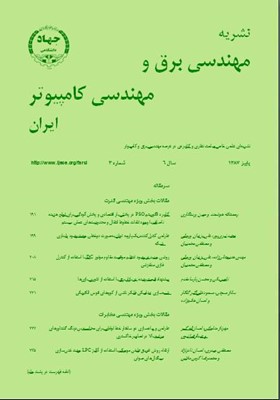شبيهسازی تأثير ريزش باران بر انتشار امواج راديويی در باندهای Ku و Ka
محورهای موضوعی : electrical and computer engineering
1 - پژوهشکده برق جهاد دانشگاهي
کلید واژه: انتشار امواجروش ممانريزش بارانپراکندگی امواج,
چکیده مقاله :
شبيهسازی تأثير باران بر روی انتشار امواج در يك محيط نيازمند دانستن اطلاعات در مورد مشخصاتی همچون ضريب شكست، شكل و اندازه قطرات است. اين پارامترها بر اساس اندازهگیری بهدست میآیند، سپس بر اين اساس ميتوان پارامترهاي پراكندگي ناشي از يك ذره را حساب نمود و در نهايت نتايج را براي مجموعه ذرات تعميم داد. در اين مقاله با استفاده از نحوه توزيع قطرات باران و با استفاده از روش ممان پارامترهایی همچون تضعیف، تغيير پلاريزاسيون و شيفت فاز محاسبه شده است. نتايج شبيهسازی با توصيههای ITU در این رابطه مقايسه شده و نشان داده شده که توصيههای ITU که حالت عام دارند بهطور تقريبی متوسطی از تضعيف را ارائه میدهند.
To simulate the effects of rain on the wave propagation, refractive index, size, and pattern of the rain drops should be characterized. By finding these parameters through the measurements, one is able to calculate scattering parameters from a particle and then extend it to a group of particles. In this study, attenuation, polarization changes, and phase shift are calculated by considering rainfall distribution and moment method. Based on the comparison of the simulation results and ITU recommendations, it is shown that ITU recommendations model is general and approximately presents average attenuation.
[1] L. W. Li, P. S. Kooi, M. S. Leong, T. S. Yeo, and M. Z. Gao, "Microwave attenuation by realistically distorted raindrops: part I-theory," IEEE Trans. on Antennas and Propagation, vol. 43, no. 8, pp. 811-822, Aug. 1995.
[2] T. Oguchi, "Electromagnetic wave propagation and scattering in rain and other hydrometeors," Proceedings of the IEEE, vol. 71, no. 9, pp. 1029-1079, Sep. 1983.
[3] L. D. Emiliani'z, J. Agudelo, E. Gutierrez, J. Restrepo, and C. Fradique - Mendez, "Development of rain - attenuation and rain - rate maps for satellite system design in the Ku and Ka bands in colombia," IEEE Antennas and Propagation Magazine, vol. 46, no. 6, pp. 54-68, Dec. 2004.
[4] L. W. Li, T. S. Yeo, P. S. Kooi, and M. S. Leong, "An efficient calculation approach to evaluation of microwave specific attenuation," IEEE AP, vol. 48, no. 8, pp. 1220-1229, Aug. 2000.
[5] A. Battaglia, F. Prodi, and O. Sturniolo, "Radar and scattering parameters through falling hydrometeors with asymmetric shapes," Applied Optics, vol. 40, no. 18, pp. 1026-1031, Jun. 2001.
[6] I. P. Shkarofsky, "Dependence of rain attenuation and cross- polarization on drop size distribution," IEEE Trans. on Antennas and Propagation, vol. 27, no. 4, pp. 538-542, Jul. 1979.
[7] C. A. Balanis, Advanced Engineering Electromagnetic, John Wiley & Sons, Inc. 1989.
[8] A. D. Yaghjian, "Electric dyadic green’s functions in the source region," in Proc. IEEE, vol. 68, no. 2, pp. 248-263, Feb. 1980.
[9] J. Tan and M. Thurai, "Rain - induced cross polarization on line - of - sigth systems at 38 GHz," IEE Proc. Microw. Antennas Propag., vol. 144, no. 1, pp. 20-26, Feb. 1997.
[10] ITU-R P.838-2, Specific Attenuation Model for Rain for Use in Prediction Methods, 2003. http://www.itu.int/md/R03-SG03-C-0032/en

